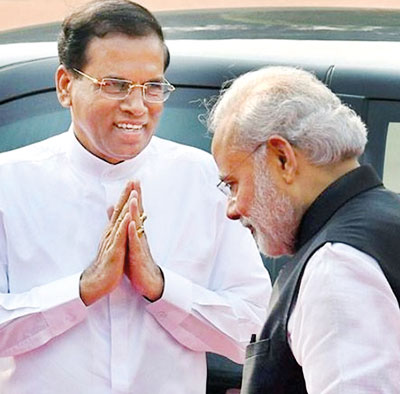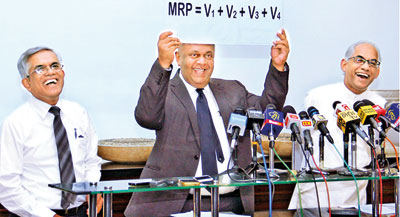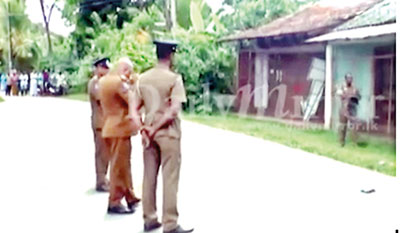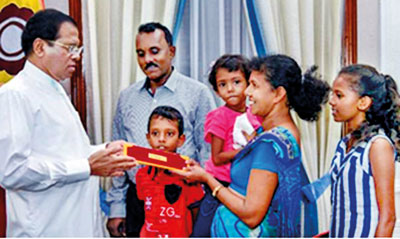Columns
Sirisena touches a raw nerve with assassination plot claim
It was not the best of all goodwill messages from Lankan President Sirisena to Indian Prime Minister Narendra Modi that Ranil Wickremesinghe would have wished he carried with him tucked in his inside coat pocket when he took flight on Thursday to New Delhi to meet his Indian counterpart and present Lanka’s credentials to be its closest neighbour’s best friend.
For the situation was dynamite and threatened to blow up the carefully cultivated friendship since 2015 between the two neighbours — one a Gulliver, the other a Lilliput — sky high overnight. Without warning. Without reason. Without purpose.
 All because of a casual remark the President was said to have made at his weekly closed-door cabinet meeting this Tuesday where he is alleged to have accused India’s intelligence service, the innocuously named Research and Analysis Wing, better known as RAW, as being the mastermind behind the recently revealed plot to kill him.
All because of a casual remark the President was said to have made at his weekly closed-door cabinet meeting this Tuesday where he is alleged to have accused India’s intelligence service, the innocuously named Research and Analysis Wing, better known as RAW, as being the mastermind behind the recently revealed plot to kill him.
And what did the missive Ranil carried on Wednesday night contain? A clarification issued by the President’s media secretary that the Lankan President had not referred to India’s main intelligence branch RAW as being the instigator or to some other unnamed Indian intelligence wing.
The statement issued by the President’s Media Division read:
“In the meeting, the President emphasised the need to conduct a comprehensive investigation into the alleged assassination plot. Among other topics discussed at various times during the said Cabinet meeting, was the development of the Eastern terminal of the Colombo Port. The President highlighted the importance of Sri Lanka has a deep-sea port terminal in the interest of the national economy.
“India and Sri Lanka have maintained cordial relations and cooperation since the inception of this Government. Several high-level visits have taken place between the two nations that have resulted in strengthening cooperation in many fields.
“The PMD also wishes to state that the High Commissioner of India called on the President this morning and during the meeting, all matters were clarified and bilateral relations were reassured.
“In these circumstances, it is very unfortunate that some parties with vested interests resort to spreading such malevolent manipulations detrimental to the existing good relations between the two countries as well as the excellent personal rapport between the two leaders.”
But would such a clarification sufficed to have doused the wrath of India’s Prime Minister. No leader of any nation will take kindly to an unfounded charge made by a foreign sovereign Head of State that his government planned to assassinate the leader of another nation.
And even before Ranil Wickremesinghe’s plane touched down at New Delhi’s airport, Indian outrage was not only swift but ferocious. Earlier in the day the Indian High Commissioner had called upon the President. Shortly thereafter Sirisena was dialling a New Delhi number to speak to Modi on line, a Modi who would certainly not have been amused by this wild charge levelled against his government of planning an assassination attempt on a foreign Head of State.
Modi may not have been amused but he was certainly pacified. Especially after being given the golden opportunity to draw his can and give Sirisena six of the best.
A statement issued by Modi’s office on Wednesday stated:
“The President of Sri Lanka Maithripala Sirisena called Prime Minister Modi on telephone today.
“The President of Sri Lanka stated that he categorically rejected the reports in sections of media about him alluding to the involvement of India in any manner whatsoever in an alleged plot to assassinate the President and a former Defence Secretary of Sri Lanka.
“He mentioned that the mischievous and mala fide reports were utterly baseless and false, and seemed intended to create misunderstanding between the two leaders as well as damage the cordial relations between the two friendly neighbours.

NAMASTHE SIR: File photo of Lankan President Sirisena greeting Indian Prime Minister Modi
“The President apprised the Prime Minister of the urgent steps taken by him personally and the Government of Sri Lanka to publicly reject these reports. In this context, he also recalled his meeting with the High Commissioner of India to Sri Lanka today morning.
“The President also stated that he regards the Prime Minister as a true friend of Sri Lanka, as also a close personal friend. He stressed that he greatly valued the mutually beneficial ties between India and Sri Lanka, and remained steadfast to work with the Prime Minister for further strengthening them.
“The Prime Minister appreciated the prompt steps taken by the President and his Government to firmly refute the malicious reports by publicly clarifying the matters.”
But whilst condemnation followed Sirisena’s seeming indiscretion, whilst local politicians flocked to the tavern to condemn it and drink to his downfall, whilst the media lashed upon it repeatedly like an unsated wind that stubbornly refuses to give up its unremitting howls, whilst India’s Modi took sanctimonious umbrage over it and used it as a punching bag to reduce sovereign Lanka to a worm and floor it and trample upon it; and whilst Sirisena himself was forced to grovel before Big Brother India’s chappals and beg forgiveness for it, none asked what the verbal crime was that the Lankan President had committed to merit this degrading treatment from these moral upstarts?
What were the words that provoked the storm and made the Indian hemisphere unleash its blinding bolt of lightning and the deafening crack of thunder upon the hapless Sirisena and forced him to squirm in surrender to a foreign power whilst he was head of a sovereign state?
According to one of India’s influential newspapers, The Hindu, the offending words Sirisena had uttered were: “the Indian national must be a RAW agent trying to kill me. The Indian PM may not be aware. That is often the case. Trump may not be aware of CIA’s similar moves.”
Do these words he is alleged to have said justify putting Sirisena in the pillory?
And why was there a need for his presidential media division to rush to defend him claiming it was a canard, even as one of his minister Mahinda Samarasinghe thought fit to earn favour by appearing to be the Lancelot in Sirisena’s Camelot rushing to his aid to provide the protective armour, stating ‘there was absolutely no basis for reports which quoted unidentified sources as having said that President Sirisena had accused the Research and Analysis Wing (RAW) of planning to assassinate him.
Yes, if Sirisena had indeed said the words he is supposed to have said — as published by the Tamil Nadu based Hindu newspaper quoting unnamed sources that ‘a RAW agent was trying to kill me’ – if he had claimed so on a public platform or at a news conference or even in Parliament that would have indeed been a good enough reason for total condemnation. And it would have been worth the racket that has ensued.
But it’s not what a Head of State says that matters but where he says it that is relevant. And it’s the failure of all to realise this salient point and distinguish the difference that has given rise to a diplomatic hullabaloo.
Even if the Lankan President had committed blasphemy against Bharat, he would have done so within the cloistered conclave of a close door cabinet chamber where all his chosen few were sworn to the unspoken oath of cabinet secrecy where what was discussed there were never leave its four walls to whisper outside to the whiling winds of gossip.
The whole concept of cabinet responsibility, practised, and adhered to, not only in Lanka but in India and Britain and many nations in the world, too, is firstly based on the cornerstone of cabinet secrecy.
It has been said that “it is no exaggeration to write that cabinet secrecy is at the heart of collective cabinet responsibility. It protects both the opinions of ministers and the process by which cabinet arrives at decisions. Because of it, the opposition in Parliament cannot establish which ministers supported a decision and which ones opposed it and attempt to exploit divisions in cabinet, thereby threatening the confidence the House of Commons has in the government. Unless ministers are able to express views, however controversial, to cabinet colleagues without fear of seeing them exploited by the opposition in Parliament and the media, they may well decide to hold back important arguments. In brief, the Westminster system of government insists on collective ministerial responsibility to Parliament and the public while cabinet secrecy enables ministers to present a united front to make the system work. Doing away with cabinet secrecy is the surest way to put the final nail in cabinet government and turn cabinet into nothing more than a focus group for the prime minister.”
Here within the cabinet room, cabinet ministers are given free rein to express their thoughts as they wish. Every minister can express his viewpoint and this includes the Prime Minister and the President. No chastity belt is tied around their mouths. They are free to speak their minds in the fullest confidence that no smoke will escape this conclave of cabinet ministers to give the slightest signal of their thoughts.
But once a consensus is reached and the matter is decided upon, the members will leave the chamber and defend the collective decision as one whilst not revealing to the outside world their own personal view on the subject concern nor the opinions expressed by another cabinet colleague.
Within that closed chamber, within that confidential confessional box if the chosen seed of government cannot free vent to their minds, then where else can they flatulate their opinions. Unheard, ‘unsmelt’, unreported.
President Sirisena had an unquestionable right to express his fears as to a potential danger to his life from a foreign secret agency to his close colleagues in the strictest confidence. He cannot be blamed and crucified purely because some of his so-called colleagues whom he had appointed to warm the ministerial seats ratted on him and chose to betray the supreme edict of cabinet government: Cabinet Secrecy.
But one deadly folly that Sirisena made, perhaps on his advisors’ instructions, is that instead of sticking to his guns and insisting that he has the supreme right to express his thoughts, wrong or right, to his cabinet colleagues in the privacy of his cabinet room and that none can question the privilege, he instead chose to be servile, deny, apologise and grovel at the feet of Modi’s Mojari.
Eureka! Mangala reveals petrol pricing suththareWhen Finance Minister Mangala Samaraweera admitted last week that he himself couldn’t make a head or tail of his own petrol pricing formula he had recently introduced to make the cost of living index rise even higher, it was akin to the sort of awkward situation that would have undoubtedly arisen had Einstein confessed in 1915 that he was baffled by his own theory and did not have the foggiest as to what his relativity hash was all about.Speaking to the media at the UNP headquarters Sirikotha in Pitakotte on October 9, he said: “Even I cannot comprehend what this pricing formula is. When people come to know what this formula is, they will also be affected mentally.”  GAME FOR A LAUGH: Finance Minister Mangala presents his Theory of Petrol Price Relativity But within a week of giving it great thought and after doing his homework burning the midnight candle at both ends, Mangala had finally seen the light and come to know of it and shouted ’eureka’ when he found to his glee he had mastered the true import of the formula that had so eluded him for so long. So much so that he deemed the discovery worthy enough to hold a press conference on Thursday to announce the final cracking of petrol pricing’s elusive Da Vinci Code. This Thursday the Finance Minister Samaraweera, flanked by State Minister Eran Wickremaratne and Finance Ministry Secretary Dr. R.H.S. Samaratunga, addressed a media conference to present his findings. And here it is: For those scientific buffs who can fathom it, it’s simply this: MRP= V1+ V2+ V3+ V4. Got it. Good. MRP, of course, does not stand for Mahinda Rajapaksa President but simply means Maximum Retail Policy. And the V1, V2, V3 and V4 do not stand for four times victory either. n V1 simply means, Mangala explained, V1 is the Landed Cost (Rs/Litre), which included Singapore Platts Price per Barrel, weighted Average Premium per Barrel, Loss due to the Evaporation and Exchange Rate (US$/LKR) are applied. n V2 stands for V2 is the Processing cost which includes local port charges, Transport Cost, Dealer’s Margin including losses due to Evaporation to dealers and stock holding cost. n V3 is the administrative expenses including personnel Cost, depreciation and other cost elements, if any. n And V4 is about the taxation which includes Customs Import Duty, Excise Duty, Ports and Airports Development Levy and National Building Tax. So there you have it, boiled down to its quintessence and served in the clearest mathematical terms. Next time you line up to fill your tank at the newest petrol price arrived at by the application of Mangala’s MRP= V1+V2+V3+V4 formula and understand why petrol prices have to be raised month by month as a demand of reality, realising Einstein’s theory of relativity expressed in the equation, E= mc2,will be child’s play. And even as you dish out more for your petrol take heart. And give yourself a hearty pat on the back. For if you can make head or tail of it: You are no dumb sucker. You are a bally genius. Where ignorance once made you curse the flaming fuel price hikes, enlightenment of MRP= V1+ V2+ V3+ V4 will surely help to douse the burning hole in your pocket. And keep your sanity on even keel. Alas for those who cannot, the only consolation is to ask: Are you Game For a Laugh? PS. The Minister also said that the tax levied in Sri Lanka is low compared to the other countries in the region. “The tax levied on petrol in India was SL Rs. 82.14 and diesel SL Rs. 47.52 but in Sri Lanka it was Rs. 53.68 for petrol and Rs. 25.48 for diesel. In England Rs. 178.70 for petrol and Rs. 180.27 for diesel.” Is that so? Really? How comforting to know we are far better off than the Indians and the British. | |
President gifts million buck reward to T 56 toting sargeOn September 29th, Police Sergeant Sanath Gunawardena attached to the Thebuwana Police stopped a lorry carrying sand and arrested the driver. According to him, the lorry driver had no permit to transport river mined sand. At the police station, however, the OIC released the driver and claimed that he did indeed have the necessary permit and, therefore, the police had no right to arrest the driver.Four days later on October 3, Sergeant Gunawardena, disgruntled and frustrated over what he considered to be an injustice and, suspecting foul play, decided to take the law literally to his own hands. He grabbed a T56 from the police armoury and staged a protest on the Thebuwana street and even fired a few shots to the air to express with gun power he pent up outrage.  CARRY ON SARGE: Thebuwana Police Sergent protesting with a T56 rifle and refusing to surrender Thebuwana police efforts to coax him to surrender his weapon and the STF had to be called in. They managed to wrestle the gun and the street drama ended. Sergeant Gunawardena was arrested and produced before court and remanded and released on surety bail. The court date was fixed for December 11. He was also interdicted pending an inquiry as to his allegations and his conduct. This Tuesday the 16th President Sirisena invited him and his family to the Presidential Secretariat and hand over a cheque of a million bucks to his wife. The following day the Inspector General of Police Pujith Jayasundera reinstated Gunawardena. All this whilst there is an inquiry pending against him, not to forget a criminal case filed against him and December 11th set as the date for his appearance in court. Oh, lucky man. The divine intervention of the President seems to have changed his fortunes overnight. Not only has he got his job back but he is also a million bucks richer for firing shots in the air with his T56 weapon on a public street after flouting orders from his superior officers. The President may have been moved by the man’s genuine sense of justice. But isn’t there another dimension to it all. That discipline in the Tri Forces and the Police is the touchstone in the chain of command. Every serving man in the forces is not only expected but is required as a must to obey without question the order of his superior officer, be it right or be it wrong. It’s not for him to debate within him philosophical issues involved in the order. Tennyson’s ‘Charge of the Light Brigade’ is one literary example – ‘for theirs not to question why, theirs but to do or die’. Rewarding insubordination in the ranks may well lead civil society down the slippery slope to anarchy.  PRESIDENTIAL APPRECIATION: Sirisena hands over a million buck cheque to him and family
|


Leave a Reply
Post Comment